Home > Asia > About Cambodia > Travel Ideas > The Angkor
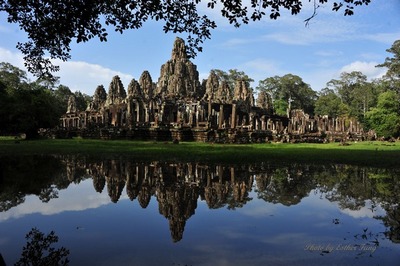
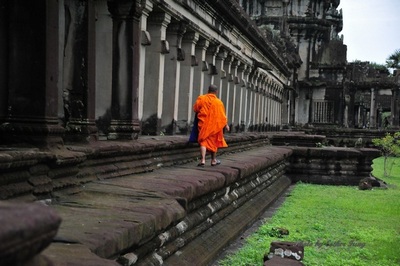
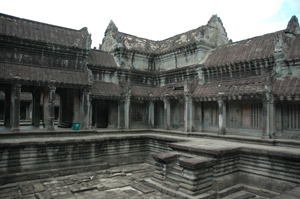
THE ANGKOR
Angkor ,the ancient capital of the powerful Khmer Empire from the 9 th-12th century, is home to one of the world's archaeological gems and remains the spiritual and cultural centre of Cambodia. The Angkor Archaeological Park consists of 70 ruins in an area of 200 square km and is home to some of the most important structures, statues and carving produced in the name of Buddhist and Hindu religions. First discovered by Western archaeologists in the late 19th century, the "Lost City of Angkor" has been re-opened to foreign visitors who can freely explore the many temples within the complex.
Angkor Wat 吳哥窟
It covering an area of one square mile (1.6 sq.km), Angkor Wat is one of the largest temple complexes in the world. The temple is dedicated to the gold Vishnu from whom the King was considered a reincarnation. Essentially a three-layered pyramid, Angkor Wat has five distinctive towers, 64 meters high. On the outer wall of Angkor Wat's first terrace are eight panels of bas relief that depict scenes of the Hindu epic Ramayana and Mahabharata, thought to be the longest continuous bas-relief in the world.
Angkor Thom (Great City) 大吳哥城
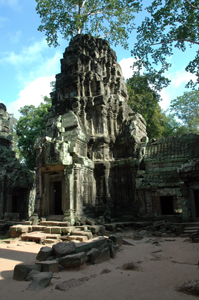 While Angkor Wat is Hindu in inspiration, Angkor Thom has more Buddhist influence with its three-dimensional representation of Buddhist cosmology and sculpted images of Buddha-like images on its temples. Built by King Jayavarman VII (1181-1218AD), Angkor Thom is immense, covering an area of four square miles (10.4 sq.km) with four major gateways and a 100 metre-wide moat extending 12 km surrounding the city. The city encloses the Royal Palace (which no longer exists) and several major temples including the Bayon and Baphuon.
While Angkor Wat is Hindu in inspiration, Angkor Thom has more Buddhist influence with its three-dimensional representation of Buddhist cosmology and sculpted images of Buddha-like images on its temples. Built by King Jayavarman VII (1181-1218AD), Angkor Thom is immense, covering an area of four square miles (10.4 sq.km) with four major gateways and a 100 metre-wide moat extending 12 km surrounding the city. The city encloses the Royal Palace (which no longer exists) and several major temples including the Bayon and Baphuon.
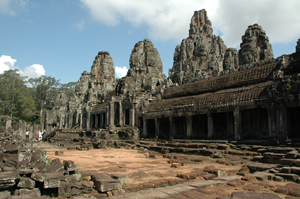 Bayon 百因廟
Bayon 百因廟
The Bayon, built as King Jayavarman VII's temple mountain, is located at the centre of Angkor Thom. The 37-tower temple is an awesome sight, each with four heads, ranging from 3-4.5 metres high. At first glance, the complex seems a shapeless mass of stone but further scrutiny reveals a face, enigmatic and silent, watching with half-closed eyes. Soon another face is made out and another and still yet another, until they are all around - silent, heavy and impressive, staring from a primitive and remote past.
Preah Khan 尼可涄寺廟
Preah Khan was King Jayavarman VII's first captial before the completion of Angkor Thom and was dedicated to his dead father. The complex includes a 2-storey columnar pavilion and a spacious hall built to accommodate the king's dancers and other members of the Khmer hierarchy. According to details inscribed on a two-metre stele discovered at the site, the temple maintenance required the services of 98,840 men and women and housed 15,000 people including monks, dancers and high-ranking officials.
Phnom Bakheng 普南巴堅
Ta Prohm (1186) 大蓬寺廟
Built by Jayavarman VII as a shrine for his mother and as a monastery devoted to its upkeep. A stele referred to the temple as a monument "whose limbs are adorned with gold and resplendent with gems." The magnificent roots of a tree pushing between the huge stone blocks of the temple have been left that way intentionally, at the suggestion of French art conservators Bernard Groslier and George Coedes, who devoted years to the understanding and preservation of the treasures of Angkor. The sight of the tree's powerful embrace of the stone evokes feelings a visitors will very likely remember forever.
Takeo
It was built by Jayavarman V. This mountain temple is an imposing 5-tier pyramid, which was one of the 1st Angkorian monuments built entirely in sandstone. Its decoration was never completed.
Elephants Terrace 大象陽臺
Terrace of the Leper King 王陽臺
At the top of this 7-meter platform stands a statue of what was thought to be the Leper King. It is in fact Yama, the god and judge of the dead. Stunning carvings adorning the walss on both sides cover the walkway. It was also built under Jayavarman VII.
Pre Rup (961) 普瑞拉普寺廟
Built by Rajendravarman, 9 years after the construction of Mebon Oriental. Composed of laterite and bricks, it is similar in style though on a much gradeur scale.
Banteay Srei (967)
It was built under Jayavarman V, it is regarded as the jewel in the crown of classical Khmer art. Its rose-colored sandstone walls are decorated with carvings and basreliefs, which are among the most accomplished Angkor has to offer. Both the standard of the work and the state of its preservation are extraordinary.
|
|---|
Newsletter Subscription: 訂閱最新旅遊資訊
Site Map · Privacy Policy 私隱政策(只附英文版)
© 2020 Exotic-Holidays.hk · All Rights Reserved
![]()